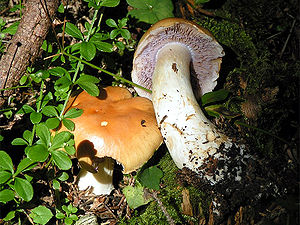Mucous heads
| Mucous heads | ||||||||||||
|---|---|---|---|---|---|---|---|---|---|---|---|---|

Brick yellow mucous head ( Cortinarius varius ) |
||||||||||||
| Systematics | ||||||||||||
|
||||||||||||
| Scientific name | ||||||||||||
| Cortinarius subg. Phlegmacium | ||||||||||||
| ( Fr. ) trough |
The subgenus of the mucous heads ( Phlegmacium ) is divided into two groups due to the shape of the stem. In addition to the mucous heads, the sub-genus - according to most authors - also includes the former sub-genus of club feet ( Bulbopodium ). The mushrooms from both groups belong to the genus Schleierlinge ( Cortinarius ).
They are medium to very large species. The most important macroscopic features of the mucous heads are the dry stem and the usually slimy surface of the hat; The club feet also usually have a pronounced, often clearly edged tuber at the lower end of the stem.
When the mushrooms' hats open, the characteristic veil of hair, the cortina , can be seen between the stem and the brim . As the fruiting body develops, only a collar-like remnant of the Cortina remains on the upper part of the stem, which is clearly colored rust-brown by the falling spores. The velum universale - a shell that completely encloses very young fruiting bodies - often leaves typical residues on the hat, on the edge of the hat and on the lower part of the handle.
description
- The hat is greasy in wet weather or if the hat seems dry, then it is brown or purple in color and the meat reacts with lye (KOH or NH 3 ) with a yellow to yellow-brown color reaction. The phlegmacs often appear with vivid colors (blue, red, yellow, green, brown, whitish etc.). The hat reaches 3–20 cm, is very fleshy and more or less shielded when fully grown.
- Always with a veil (Cortina), in the early stages of development there is always a Velum universale (never slimy!), Later disappearing.
- The stem is dry, more or less evenly thick, club-shaped or with a bulbous to rounded-bulbous base. The surface of the stem is smooth to silky-fibrous, more rarely lumpy to scaly-belted.
- Younger mushrooms have differently colored lamellae depending on the species . The spectrum ranges from pale clay colors, yellow, yellow-green as well as lavender, gray-blue or blue-violet to violet-colored lamellae. The ripe, bulged lamellae are also colored ocher to rust brown by the rust-brown spore powder .
Microscopic features
- The spores are usually warty, almond to lemon-shaped, rarely spindle-shaped or rounded.
- Cystides are rare.
Occurrence
The mucous heads grow mainly in autumn and, like all veils, always on the ground, but always in connection with trees, as they are obligatory mycorrhizal fungi .
Food value
Anyone who can make a reliable determination will find in this group, in addition to extremely poisonous and many inedible species as well as species with suspicious food value, also some rich edible mushrooms. This also applies to the only hair veil permitted as a market mushroom in Switzerland, the barn owl ( Cortinarius praestans ).
Systematics
Because of the shape of the stem, the subgenus is divided into two larger groups, mucous heads and club feet. The mucous heads have a cylindrical to clubfoot thickened stalk, the club feet have a bulbous, sometimes also a rounded bulbous stem base.
For the further macroscopic determination of the species, the color of the lamellae and hair veils on young fruiting bodies is of great importance. The color of the hat and the handle, the surface of the hat and the handle, changes in the color of the meat or the skin of the hat when it comes into contact with lye ( potassium hydroxide or ammonia ) are used to further differentiate . Contact with certain trees also helps to differentiate between species.
The subdivision into sections (+ example type) is modified according to Bon (1988):
Mucous heads ( Phlegmacium ):
- Section: Elastici
- Bitter mucous head ( Cortinarius infractus )
- Section: Phlegmacium
- White- booted mucous head ( Cortinarius claricolor )
- Section: Triumphantes
- Yellow-booted mucous head ( Cortinarius triumphans )
- Section: Percomes
- Spicy mucous head ( Cortinarius percomis )
- Section: Variecolores
- Barn Owl or Blue Booted Mucous Head ( Cortinarius praestans )
Club feet ( Bulbopodium ):
- Section: Leucophylli
- Saw-bladed clubfoot ( Cortinarius multiformis )
- Section: Virentophylli
- Violet Clubfoot ( Cortinarius rufoolivaceus )
- Section: Xanthophylli
- Magnificent clubfoot ( Cortinarius elegantissimus )
- Section: Cyanophylli
- Purple-spotted clubfoot ( Cortinarius purpurascens )
Images of mucous heads
Earthy-smelling mucous head
( Cortinarius variecolor )
literature
- Marcel Bon: Parey's book of mushrooms , Paul Parey publishing house, Hamburg, Berlin, 1988, ISBN 3-490-19818-2
Web links
- The Phlegmacium Website - an excellent site on the subgenus Phlegmacium, with lots of pictures of rare species
- Ünal Bussaglia: genus Cortinarius (Fr.) (hair veils). (PDF, 193 kB) Archived from the original on October 13, 2007 ; Retrieved April 2, 2013 .



